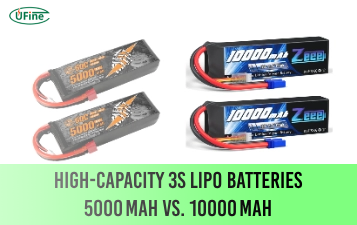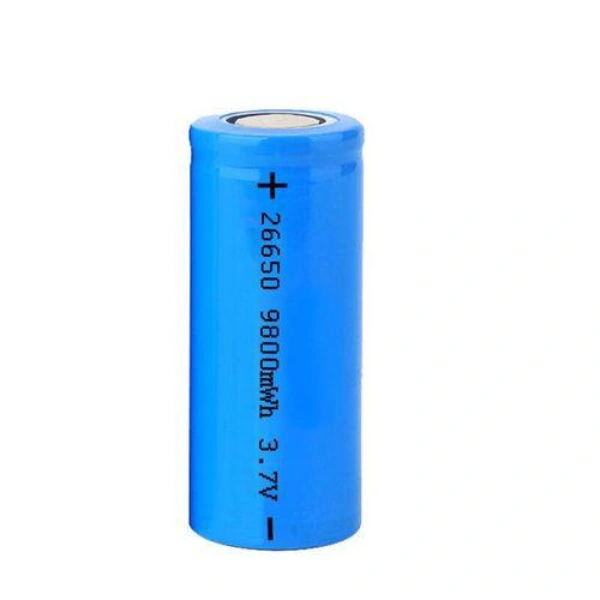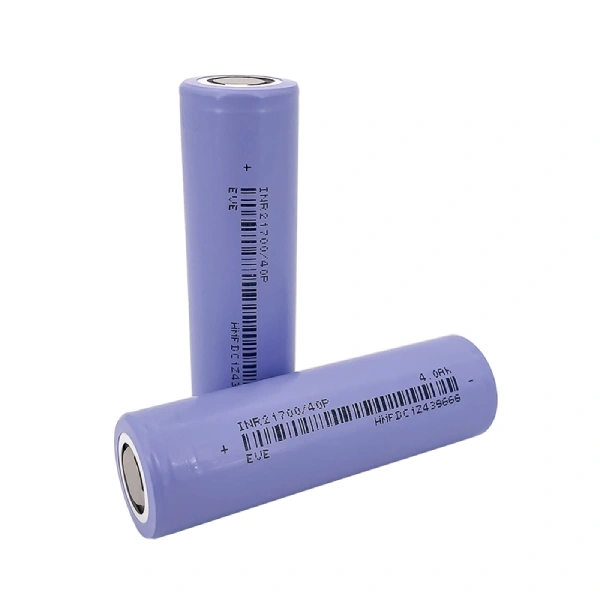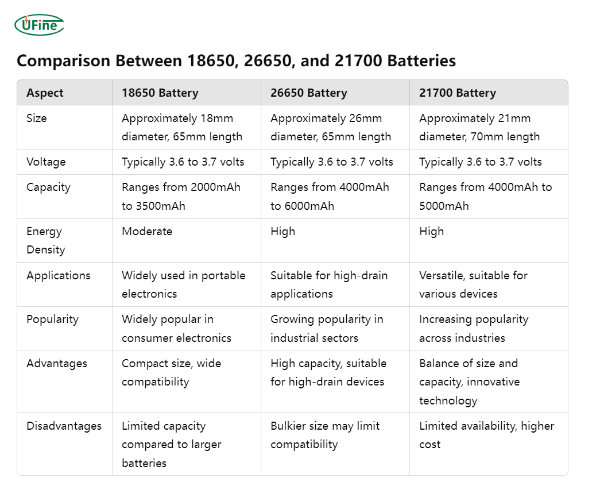18650 vs 26650 vs 21700: Which Battery is Right for You? These batteries, widely used in various electronic devices, possess unique features and applications. Let’s explore their characteristics, advantages, and drawbacks to understand which one suits your needs best. How do these batteries stack up against each other regarding performance and usability? Let’s delve into the details to find out.
Part 1. What is an 18650 battery?
The 18650 battery, a stalwart of portable power, boasts a cylindrical shape with dimensions approximately 18mm in diameter and 65mm in length. Initially developed in the 1990s, its name stems from its size: 18mm by 65mm. Initially used in laptops and other portable electronics, its popularity surged due to its versatility and reliability. With a typical voltage range of 3.6 to 3.7 volts and capacities ranging from 2000mAh to 3500mAh, it remains a cornerstone of rechargeable battery technology, powering everything from flashlights to electric vehicles.
Specifications:
- Voltage: Typically ranges from 3.6 to 3.7 volts.
- Capacity: Varies from around 2000mAh to 3500mAh, depending on the brand and model.
- Chemistry: Usually composed of lithium-ion chemistry, offering high energy density.
Advantages:
- High Energy Density: Provides a substantial amount of power in a compact size, making it ideal for portable electronic devices like laptops, flashlights, and vaporizers.
- Rechargeable: Can be recharged hundreds of times, reducing waste and saving money in the long run.
- Versatility: Compatible with various devices, offering a convenient power source for multiple applications.
- Reliable Performance: Known for stable voltage output and consistent performance throughout its lifespan.
Disadvantages:
- Risk of Overheating: Improper use or charging may lead to overheating or even explosion, emphasizing the importance of proper handling and charging practices.
- Limited Lifespan: While rechargeable, 18650 batteries have a finite number of charge cycles before their capacity begins to degrade.
- Sensitive to Environment: Extreme temperatures and moisture exposure can affect the battery’s performance and lifespan.
- Counterfeits: Due to their popularity, there’s a risk of purchasing counterfeit 18650 batteries, which may pose safety hazards and provide inferior performance.
Part 2. What is a 26650 battery?
The 26650 battery, a larger cousin of the 18650, emerged in the mid-2000s to meet the demands of high-drain applications. Measuring around 26mm in diameter and 65mm in length, its increased size allows for higher capacity and power output. Initially utilized in electric vehicles and industrial machinery, it has since found its way into high-performance flashlights, power tools, and solar energy storage systems. With capacities ranging from 4000mAh to 6000mAh and a voltage of 3.6 to 3.7 volts, the 26650 battery continues to power innovation in various fields.
Specifications:
- Size: Measures approximately 26mm in diameter and 65mm in length, making it more significant than the standard 18650 battery.
- Voltage: Typically ranges from 3.6 to 3.7 volts, similar to other lithium-ion batteries.
- Capacity: Offers higher capacity than 18650 batteries, typically ranging from 4000mAh to 6000mAh.
- Chemistry: Composed of lithium-ion chemistry, providing high energy density and long-lasting power.
Advantages:
- Increased Capacity: The larger size allows for a higher capacity, making it suitable for devices that require more power and longer runtime.
- Longer Lifespan: With its higher capacity and robust construction, 26650 batteries have a longer lifespan than smaller ones.
- Suitable for High-Drain Devices: Ideal for high-drain devices such as electric vehicles, power tools, and large flashlights that demand sustained high power output.
- Enhanced Heat Dissipation: The larger size allows for better heat dissipation, reducing the risk of overheating during heavy use.
Disadvantages:
- Bulkier Size: Due to its larger dimensions, 26650 batteries may not be suitable for devices with limited space or those designed for smaller batteries.
- Limited Compatibility: Not all devices are compatible with 26650 batteries, as they require specific battery compartments and may not fit standard battery slots.
- Higher Cost: Generally, 26650 batteries are more expensive than their smaller counterparts, like the 18650 battery, which may impact overall device cost.
Part 3. What is a 21700 battery?
The 21700 battery, a relative newcomer to the lithium-ion scene, debuted in the early 2010s, promising even more significant energy density and performance. It balances size and capacity with dimensions approximately 21mm in diameter and 70mm in length. Initially developed for electric vehicles and renewable energy storage, its compact design and high capacity quickly gained traction in consumer electronics. The 21700 battery, boasting capacities ranging from 4000mAh to 5000mAh and a voltage of 3.6 to 3.7 volts, represents the cutting edge of rechargeable battery technology, driving innovation across industries.
Specifications:
- Size: Measures approximately 21mm in diameter and 70mm in length, making it slightly larger than the 18650 battery and offering increased capacity.
- Voltage: Typically ranges from 3.6 to 3.7 volts, similar to other lithium-ion batteries.
- Capacity: Offers higher capacity than 18650 and 26650 batteries, typically ranging from 4000mAh to 5000mAh.
- Chemistry: Composed of lithium-ion chemistry, providing high energy density and reliable power output.
Advantages:
- Higher Energy Density: The 21700 battery offers a higher energy density, allowing more power to be packed into a smaller space, making it ideal for compact devices requiring long-lasting power.
- Improved Performance: With its larger size and increased capacity, the 21700 battery delivers better performance than smaller batteries, offering longer runtime and higher power output.
- Enhanced Safety: Many 21700 batteries have advanced safety features such as built-in protection circuits to prevent overcharging, over-discharging, and short circuits, ensuring safe and reliable operation.
- Compatibility: While more significant than the standard 18650 battery, the 21700 battery is still compatible with many devices, including flashlights, laptops, electric vehicles, and more.
Disadvantages:
- Limited Availability: Manufacturers may limit the availability of 21700 batteries due to their relatively recent introduction to the market compared to more established battery types like the 18650.
- Higher Cost: 21700 batteries may be more expensive than standard 18650 batteries, impacting the overall cost of devices utilizing this battery type.
- Size and Weight: While offering higher capacity and performance, the larger size and weight of the 21700 battery may only be suitable for some devices, particularly those designed for smaller batteries.
Part 4. Comparison between 18650, 26650, and 21700 batteries
Size and Dimensions:
- 18650: Measures approximately 18mm in diameter and 65mm in length.
- 26650: Larger, with dimensions around 26mm in diameter and 65mm in length.
- 21700: Falls between 18650 and 26650 in size, measuring approximately 21mm in diameter and 70mm in length.
Capacity:
- 18650: Typically offers capacities ranging from 2000mAh to 3500mAh.
- 26650: Boasts higher capacity, ranging from 4000mAh to 6000mAh.
- 21700: Offers comparable capacity to the 26650, typically ranging from 4000mAh to 5000mAh.
Voltage:
- 18650, 26650, 21700: All three battery types typically operate within the same voltage range of 3.6 to 3.7 volts.
Applications:
- 18650: Widely used in various consumer electronics, including laptops, flashlights, and vaping devices.
- 26650: Primarily utilized in high-drain applications such as electric vehicles, power tools, and solar energy storage systems.
- 21700: Finding increasing adoption in consumer electronics, electric vehicles, and renewable energy storage due to its balance of size and capacity.
Which Battery Type is Best for High-Drain Devices?
If you are using high-drain devices like power tools, electric vehicles, or high-performance flashlights, the 26650 and 21700 batteries are the better choices. The 26650 offers a larger capacity, perfect for tools requiring sustained high power, while the 21700 strikes a balance between size and capacity, making it suitable for both high-drain devices and compact electronics.
Performance:
- 18650: Offers reliable performance and versatility for everyday use in a wide range of devices.
- 26650: Delivers high performance and longer runtime, ideal for demanding applications that require sustained power output.
- 21700: Provides enhanced energy density and performance compared to the 18650, making it suitable for power-hungry devices and emerging technologies.
Which Battery Offers the Best Performance: 18650, 26650, or 21700?
When choosing between 18650, 26650, and 21700 batteries, it’s essential to consider the power needs of your device. The 18650 offers compactness and reliability, making it ideal for portable electronics. However, if your device demands higher power output or longer run-time, the 26650 and 21700 are better choices. The 21700, with its balance of energy density and performance, often surpasses the 18650 in power-hungry applications such as electric vehicles and advanced flashlights.
Cost:
- 18650: Generally more affordable than more significant battery types like the 26650 and 21700.
- 26650 and 21700: They tend to be more expensive due to their larger size and higher capacity, impacting the overall cost of devices utilizing these batteries.
Availability:
- 18650: Widely available due to its long-standing presence in the market and extensive use in consumer electronics.
- 26650, 21700: While gaining popularity, these battery types may have limited availability compared to the ubiquitous 18650.
Compatibility:
- 18650, 26650, 21700: Each battery type requires specific compartments and may not be compatible with all devices. However, adapters or modifications may be available to accommodate different battery sizes.
| Feature | 18650 Battery | 26650 Battery | 21700 Battery |
|---|---|---|---|
| Size (Diameter x Length) | 18mm x 65mm | 26mm x 65mm | 21mm x 70mm |
| Capacity | 2000mAh – 3500mAh | 4000mAh – 6000mAh | 4000mAh – 5000mAh |
| Voltage | 3.6V – 3.7V | 3.6V – 3.7V | 3.6V – 3.7V |
| Energy Density | Moderate | High | High |
| Applications | Laptops, Flashlights, Vaping | Electric Vehicles, Power Tools, Solar Energy | Electric Vehicles, Consumer Electronics |
| Performance | Reliable for Small Devices | High Performance, Long Runtime | Enhanced Performance, High Energy Density |
| Cost | Affordable | Expensive | Expensive |
| Availability | Widely Available | Limited Availability | Increasing Popularity |
| Compatibility | Widely Compatible | Limited Compatibility | Increasing Compatibility |
| Lifespan | Moderate | Longer Lifespan | Longer Lifespan |
Explore More:
18650 Battery vs 16650 Battery14500 Battery Vs. 18650 Battery4680 Battery Cell vs 1865026650 vs 18650 Rechargeable Batteries
Part 5. FAQs
-
Are 18650, 26650, and 21700 batteries interchangeable?
No, these batteries are not interchangeable due to differences in size and specifications. Each battery type has unique dimensions and capacities, so it’s essential to use the correct battery size and type recommended by the device manufacturer. -
What are the main advantages of using a 26650 battery over an 18650 battery?
The primary advantage of a 26650 battery is its larger size, which allows for higher capacity and power output. This makes it ideal for high-drain applications such as electric vehicles and power tools, where longer runtime and increased performance are essential. -
Can I use a 21700 battery in devices designed for 18650 batteries?
It depends on the device and its battery compartment size. While a 21700 battery may offer higher capacity and performance, it may not fit into devices explicitly designed for 18650 batteries. Check the device’s specifications and compatibility before using a different battery size. -
How do I know which battery type is best for my device?
Consider the power requirements and size constraints of your device. If you need a compact battery with moderate capacity, an 18650 battery may be suitable. A 26650 or 21700 battery may offer better performance and longer runtime for high-drain applications or larger devices. -
Are there any safety concerns associated with using lithium-ion batteries like the 18650, 26650, and 21700?
While lithium-ion batteries are generally safe when handled properly, safety risks include overheating, short circuits, and improper charging. It’s essential to follow manufacturer guidelines for charging, storage, and usage to minimize the risk of accidents. -
Which battery lasts longer: 26650 or 21700?
The 26650 battery, with its higher capacity, tends to last longer than the 21700 in most high-power applications. However, the 21700 offers superior energy density, which makes it the better option for compact, high-performance devices. -
Are 18650 batteries still relevant in 2025?
Yes, 18650 batteries remain relevant due to their affordability, availability, and reliability. They continue to be a popular choice in devices such as laptops, flashlights, and vaping equipment.
Related Tags:
More Articles

High‑Capacity 3S LiPo Batteries: 5000 mAh vs. 10000 mAh
Compare 3S LiPo 5000mAh vs 10000mAh batteries by weight, power, and use. Find the best fit for your drone, RC car, or boat setup.
Top 5 Applications for Small 3S LiPo Batteries
Small 3S LiPo batteries power drones, RC gear, wearables, and robotics with high energy and low weight. Making them ideal for compact electronics projects.
Building and Charging Your Own 3S LiPo Pack: A Step‑by‑Step Guide
Learn how to build, balance, and charge a 3S LiPo battery pack safely at home with this complete DIY guide for hobbyists and beginners.
How to Choose the Right LiPo Battery Plug Type?
Discover the best LiPo battery plug types, how to choose them, and expert tips for safe usage, soldering, and maintenance.
Choosing the Right Connector for Your 3S LiPo Battery
Choosing the right 3S LiPo connector depends on current, space, and use. Learn the pros and cons of XT60, JST, EC3, and more.







